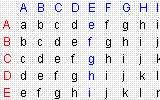Data Protection and Security |
||||||
I |
Introduction To Cryptography |
|||||
I.III |
Historic Examples of Simple Ciphers |
|||||
Vigenere Cipher Let m be some fixed positive integer. Define P=C=K= (Z26)m. For a key K = (k1,k2, ..., km), we define EK(x1,x2,...,xm)=(x1+k1,x2+k2,...,xm+km) DK(y1,y2,...,ym)=(y1-k1,y2-k2,...,ym-km) where all operations are performed in Z26 Properties:
|
|
|||||
|
||||||
|
concepts » | |||||
